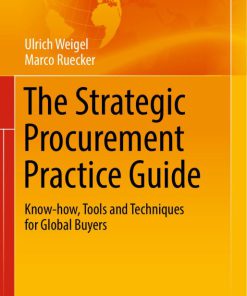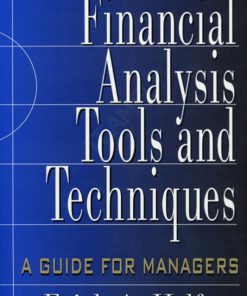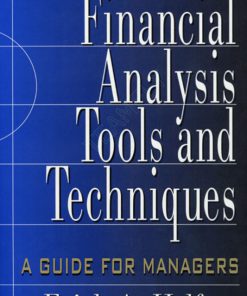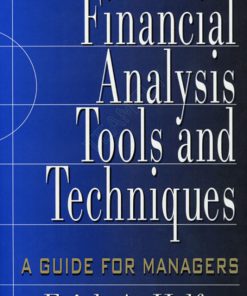Financial Analysis Tools And Techniques A Guide For Managers 1st Edition by Erich Helfert 0071378340 9780071378345
$50.00 Original price was: $50.00.$25.00Current price is: $25.00.
Authors:Erich A.Helfert , Author sort:A.Helfert, Erich , Languages:Languages:eng , Published:Published:May 1999
Financial Analysis Tools And Techniques A Guide For Managers 1st Edition by Erich Helfert – Ebook PDF Instant Download/Delivery. 0071378340, 9780071378345
Full download Financial Analysis Tools And Techniques A Guide For Managers 1st Edition after payment

Product details:
ISBN 10: 0071378340
ISBN 13: 9780071378345
Author: Erich A. Helfert
Praise for Financial Analysis Tools and Techniques: ‘Bona fide treasury for executives, managers, entrepreneurs. Have long used this great work in corporate & university programs. Uniquely makes the arcane clear.’Allen B. Barnes, Provost, IBM Advanced Business Institute ‘A candidate for every consultant-to-management’s bookshelf. Its beauty lies in the dynamic model of the business system and its management decision framework.’Stanley Press CMC, Book review in C2M Consulting to Management Journal ‘Goes a long way to remove the mystery from business finance. Approach allows managers from all areas to understand how their decisions impact shareholder value.’Stephen E. Frank, Chairman and Chief Executive Officer, Southern California Edison ‘Helfert has rare ability to make financial concepts understandable to those lacking financial background. His finance seminars exceeded our high expectations.’L. Pendleton Siegel, Chairman and Chief Executive Officer, Potlatch Corporation ‘Commend the clarity, organization and currency of contents. There is no other book available that does the task in such an understandable and accessible way.’Dr. Thomas F. Hawk, Frostburg State University ‘Helfert’s excellent overviews and simplified models effectively broadened our managers’ understanding of their fiscal responsibility to HP and our shareholders.’Robert P. Wayman, Executive Vice President, Chief Financial Officer, Hewlett-Packard Company ‘The book has become a classic, and Helfert has been of substantial help to my company in teaching our people how to think about the numbers which drive it.’Robert J. Saldich, President and Chief Executive Officer, Raychem Corporation ‘Helfert has contributed to the development of financial skills of TRW managers through his book, case studies and presentations, and highly rated instruction.’Peter S. Hellman, President and Chief Operating Officer, TRW Inc. ‘Helfert has the ability to make financial concepts understandable, and his credibility and content added significantly to the success of our educational effort.’Giulio Agostini, Senior Vice President Finance, and Office Administration, 3M Corporation ‘Helfert’s writing and teaching have become a mainstay for us, and his business and strategic sense have been recognized as valuable guides to our process.’William H. Clover, Ph.D.,
Financial Analysis Tools And Techniques A Guide For Managers 1st Table of contents:
Chapter 1: The Challenge of Financial/Economic Decision-Making
Lessons for the Millennium
The New Economy
Some Key Questions
The Basics Never Change
The Economic Manager
Understanding Business Economics
Appropriate Economic Tools
The Practice of Financial/Economic Analysis
Day-to-Day Decisions and Operational Planning
Supporting Strategy Development
Performance Assessment and Incentives
Valuation and Investor Communication
The Value Creating Company
Relevant Decision Information
Economic Incentives
Total Systems Management
Summary
Chapter 2: A Systems Context For Financial Management
A Dynamic Perspective of Business
Decision Context
The Business System
Investment Decisions
Operating Decisions
Financing Decisions
Interrelationship of Strategy and Value Creation
The Nature of Financial Statements
The Balance Sheet
The Income Statement
The Cash Flow Statement
The Statement of Changes in Shareholders’ (Owners’) Equity
The Context of Financial Analysis
Key Issues
Summary
Analytical Support
Selected References
Chapter 3: Managing Operating Funds
Funds Flow Cycles
The Funds Cycle for Manufacturing
The Funds Cycle for Sales
The Funds Cycle for Services
Variability of Funds Flows
Growth/Decline Variations
Seasonal Variations
Cyclical Variations
Generalized Funds Flow Relationships
Interpreting Funds Flow Data
Funds Management and Shareholder Value
Cash Management
Working Capital Management
Investment Management
Key Issues
Summary
Analytical Support
Selected References
Chapter 4: Assessment of Business Performance
Ratio Analysis and Performance
Management’s Point of View
Operational Analysis
Gross-Margin and Cost-of-Goods-Sold Analysis
Profit Margin
Operating Expense Analysis
Contribution Analysis
Resource Management
Asset Turnover
Working Capital Management
Profitability
Return on Assets (ROA or RONA)
Return on Assets before Interest and Taxes
Owners’ Point of View
Investment Return
Return on Equity (Shareholders’ Investment)
Return on Common Equity (ROE)
Earnings per Share
Cash Flow per Share
Share Price Appreciation
Total Shareholder Return (TSR)
Disposition of Earnings
Dividends per Share
Dividend Yield
Payout/Retention
Dividend Coverage
Dividends to Assets
Market Indicators
Price/Earnings Ratio
Cash Flow Multiples
Market-to-Book Ratio
Relative Price Movements
Value Drivers
Value of the Firm
Lenders’ Point of View
Liquidity
Current Ratio
Acid Test
Quick Sale Value
Financial Leverage
Debt to Assets
Debt to Capitalization
Debt to Equity
Debt Service
Interest Coverage
Burden Coverage
Fixed Charges Coverage
Cash Flow Analysis
Ratios as a System
Elements of Return on Assets
Elements of Return on Equity
Integration of Financial Performance Analysis
Some Special Issues
Inventory Costing
Depreciation Methods
The Impact of Inflation
Key Issues
Summary
Analytical Support
Selected References
Chapter 5: Projection of Financial Requirements
Pro Forma Financial Statements
Pro Forma Income Statement
Pro Forma Balance Sheet
Pro Forma Cash Flow Statement
Cash Budgets
Operating Budgets
Sales Budget
Production Budget
Interrelationship of Financial Projections
Financial Modeling
Sensitivity Analysis
Key Issues
Summary
Analytical Support
Selected References
Chapter 6: Dynamics and Growth of the Business System
Leverage
Operating Leverage
Effect of Lower Fixed Costs
Effect of Lower Variable Costs
Effect of Lower Prices
Multiple Effects on Break-Even Conditions
Target Profit Analysis
Financial Leverage
Financial Growth Plans
Basic Financial Growth Model
Sustainable Growth and the Sustainable Growth Equation
Integrated Financial Plan
Key Issues
Summary
Analytical Support
Selected References
Chapter 7: Cash Flows and the Time Value of Money
The Time Value of Money
Discounting, Compounding, and Equivalence
Components of Analysis
Net Investment
Net Operating Cash Inflows
Economic Life
Terminal (Residual) Value
Methods of Analysis
Simple Measures
Payback
Simple Rate of Return
Economic Investment Measures
Net Present Value
Present Value Payback
Profitability Index (BCR)
Internal Rate of Return (IRR, Yield)
Annualized Net Present Value
Applying Time-Adjusted Measures
Key Issues
Summary
Analytical Support
Selected References
Chapter 8: Analysis of Investment Decisions
Strategic Perspective
Decisional Framework
Problem Definition
Nature of the Investment
Future Costs and Benefits
Incremental Cash Flows
Relevant Accounting Data
Sunk Costs
Refinements of Investment Analysis
A Machine Replacement
Net Investment Refined
Operating Cash Inflows Refined
Unequal Economic Lives
Capital Additions and Recoveries
Analytical Framework
A Business Expansion
Mutually Exclusive Alternatives
Maintain versus Replace
Full-Fledged versus Economy Solution
Comparing Different Scenarios
Dealing with Risk and Changing Circumstances
Specifying Risk
Ranges of Estimates
Business Investments as Options
Probabilistic Simulation
Risk-Adjusted Return Standards
When to Use Investment Measures
Some Further Considerations
Leasing—A Financing Choice
Accelerated Depreciation
Inflation and Investment Analysis
Accuracy
Key Issues
Summary
Analytical Support
Selected References
Chapter 9: Cost of Capital and Business Decisions
Decisional Context
Investment Decisions
Operating Decisions
Financing Decisions
Cost of Operating Funds
Cost of Long-Term Debt
Cost of Shareholders’ Equity
Preferred Stock
Common Equity
Dividend Approach to Cost of Common Equity
Risk Assessment Approach to Cost of Common Equity
Inflation
Weighted Cost of Capital
Cost Choices
Weighting the Proportions
Market versus Book Values
Calculating the Weighted Cost of Capital
Cost of Capital and Return Standards
Cost of Capital as a Cutoff Rate
Risk Categories
Cost of Capital in Multibusiness Companies
Multiple Rate Analysis
Key Issues
Summary
Analytical Support
Selected References
Chapter 10: Analysis of Financing Choices
Framework for Analysis
Cost of Incremental Funds
Risk Exposure
Flexibility
Timing
Control
The Choice
Techniques of Calculation
Current Performance
Long-Term Debt in the Capital Structure
Preferred Stock in the Capital Structure
Common Stock in the Capital Structure
Range of Earnings Chart
The Optimal Capital Structure
Some Special Forms of Financing
Leasing
Convertible Securities
Stock Rights
Warrants
Key Issues
Summary
Analytical Support
Selected References
Chapter 11
Chapter 11: Valuation and Business Performance
Definitions of Value
Economic Value
Market Value
Book Value
Liquidation Value
Breakup Value
Reproduction Value
Collateral Value
Assessed Value
Appraised Value
Going Concern Value
Shareholder Value
Value to the Investor
Bond Values
Bond Yields
Bond Provisions and Value
Preferred Stock Values
Preferred Stock Provisions and Value
Common Stock Values
Earnings and Common Stock Value
Common Stock Yield and Investor Expectations
Other Considerations in Valuing Common Stock
Specialized Valuation Issues
Rights and Warrants
Options
Business Valuation
Valuing the Equity
Valuing the Total Company
Using Shortcuts in Valuing an Ongoing Business
Key Issues
Summary
Analytical Support
Selected References
Chapter 12: Managing for Shareholder Value
Shareholder Value Creation in Perspective
Evolution of Value-Based Methodologies
A Review of Key Measures
Earnings Measures
Cash Flow Measures
Value Measures
Economic Profit and CFROI
Creating Value in Restructuring and Combinations
Restructuring and Value
Combinations and Synergy
Combinations and Share Values
Integration of Value Analysis
Perspectives
Expectations
Time Period
Cash Flow Pattern
Ongoing Values
Comparables
Negotiations
Key Issues
Summary
Analytical Support
Selected References
Appendix 1: Financial Analysis Using Financial Genome
Financial Genome as a Financial Analysis and Planning Tool
Financial Genome as a Learning Device and Guide
How to Obtain Financial Genome
Appendix 2: Glossary of Key Terms and Concepts
Appendix 3: Financial Information and On-Line Sources
Current Financial Information
Stock Quotations
On-Line Stock Market Data
On-Line Company Data
Printed Stock Market Data
Foreign Exchanges
Mutual Funds
Options
Bond Quotations
Other Financial Data
Foreign Exchange
Financial and Economic Information
Business and Economic Magazines
Major Periodicals
Other Periodicals
Other Background Information
Annual Reports
Financial Manuals and Services
Business to Government Reporting
Trade Associations
Econometric Services
Selected References
Appendix 4: Basic Inflation Concepts
Price Level Changes
Monetary Inflation
Nominal and Real Dollars
Applications of Inflation Adjustment in Financial Analysis
Impact of Inflation
Appendix 5: Some Issues in Multinational Financial Analysis
General Performance Analysis Challenges
International Performance Analysis Challenges
Foreign Subsidiaries Operating in a Single Country
Subsidiaries Operating across Foreign Borders
People also search for Financial Analysis Tools And Techniques A Guide For Managers 1st:
financial analysis tools and techniques
tools of financial analysis and planning
tools of financial analysis
different tools of financial analysis












